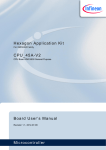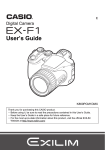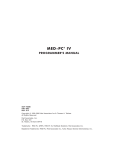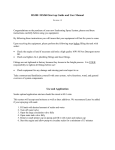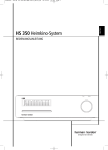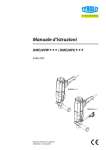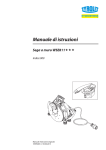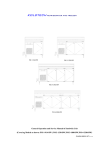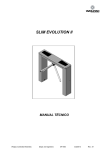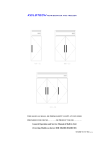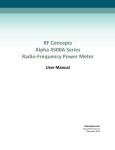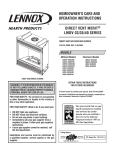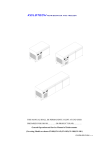Download S a f e t y I n s t r u c t i o n s
Transcript
DATaRec 4 Series User Manual ! Before putting the product into operation for the first time, make sure to read the following Safety Instructions ! It is your responsibility to use the product in an appropriate manner. This product is designed for use solely in industrial and laboratory environments or in the field and must not be used in any way that may cause personal injury or property damage. You are responsible if the product is used for an intention other than its designated purpose or in disregard of the manufacturer's instructions. The manufacturer shall assume no responsibility for such use of the product. The product is used for its designated purpose if it is used in accordance with its product documentation and within its performance limits. Using the product requires technical skills and a basic knowledge of English. It is therefore essential that the product be used exclusively by skilled and specialized staff or thoroughly trained personnel with the required skills. If personal safety gear is required for using Heim Systems products, this will be indicated at the appropriate place in the product documentation. Observing the safety instructions will help prevent personal injury or damage of any kind caused by dangerous situations. Therefore, carefully read through and adhere to the following safety instructions before putting the product into operation. It is also absolutely essential to observe the additional safety instructions on personal safety that appear in relevant parts of the product documentation. In these safety instructions, the word "product" refers to all merchandise sold and distributed by the Heim Systems, including instruments, systems and all accessories. i DATaRec 4 Series User Manual Symbols and Safety Lables ii Observe product documentation Weight indication for units >18 kg Danger of electric shock Warning! Hot surface PE terminal Ground Ground terminal Attention! Electrostatic sensitive decices Supply voltage ON/OFF Standby indication Direct current (DC) Alternating current (AC) Direct / alternating current (DC/AC) Device fully protected by double / reinforced insulation DATaRec 4 Series User Manual Tags and their Meaning ! ! ! DANGER This tag indicates a definite hazard carrying a high risk of death or serious injury if not avoided. WARNING This tag indicates a possible hazard carrying a medium risk of death or (serious) injury if not avoided. CAUTION This tag indicates a hazard carrying a low risk of minor or moderate injury if not avoided. NOTICE This tag indicates the possibility of incorrect use that can cause damage to the product. Note: The bubble indicates important details. Equipment malfunction may result if they are ignored. Tip: Special remarks are marked with a bulb. These tags are in accordance with the standard definition for civil applications in the European Economic Area. Definitions that deviate from the standard definition may also exist in other economic areas or military applications. It is therefore essential to make sure that the tags described here are always used only in connection with the related product documentation and the related product. The use of tags in connection with unrelated products or documentation can result in misinterpretation and thus contribute to personal injury or material damage. iii DATaRec 4 Series User Manual Basic Safety Instructions 1. The product may be operated only under the operating conditions and in the positions specified by the manufacturer. Its ventilation must not be obstructed during operation. 2. Applicable local or national safety regulations and rules for the prevention of accidents must be observed in all work performed. The product may be opened only by authorized, specially trained personnel. Prior to performing any work on the product or opening the product, the product must be disconnected from the supply network. Any adjustments, replacements of parts, maintenance or repair must be carried out only by technical personnel authorized by Heim Systems. Only original parts may be used for replacing parts relevant to safety (e.g. power switches, power transformers, fuses). A safety test must always be performed after parts relevant to safety have been replaced (visual inspection, PE conductor test, insulation resistance measurement, leakage current measurement, functional test). 3. As with all industrially manufactured goods, the use of substances that induce an allergic reaction (allergens, e.g. nickel) such as aluminum cannot be generally excluded. If you develop an allergic reaction (such as a skin rash, frequent sneezing, red eyes or respiratory difficulties), consult a physician immediately to determine the cause. 4. If products/components are mechanically and/or thermically processed in a manner that goes beyond their intended use, hazardous substances (heavy-metal dust such as lead, beryllium, nickel) may be released. For this reason, the product may only be disassembled, e.g. for disposal purposes, by specially trained personnel. Improper disassembly may be hazardous to your health. National waste disposal regulations must be observed. 5. Depending on the function, certain products can produce an elevated level of electromagnetic radiation. Considering that unborn life requires increased protection, pregnant women should be protected by appropriate measures. Persons with pacemakers may also be endangered byelectromagnetic radiation. The employer/operator is required to assess workplaces where there is a special risk of exposure to radiation and, ifnecessary, take measures to avert the danger. 6. Operating the products requires special training and intense concentration. Make certain that persons who use the products are physically, mentally and emotionally fit enough to handle operating the products; otherwise injuries or iv DATaRec 4 Series User Manual material damage may occur. It is the responsibility of the employer to select suitable personnel for operating the products. 7. Prior to switching on the product, it must be ensured that the nominal voltage setting on the product matches the nominal voltage of the AC supply network. If a different voltage is to be set, the power fuse of the product may have to be changed accordingly. 8. In the case of products of safety class I with movable power cord and connector, operation is permitted only on sockets with earthing contact and protective earth connection. 9. Intentionally breaking the protective earth connection either in the feed line or in the product itself is not permitted. Doing so can result in the danger of an electric shock from the product. If extension cords or connector strips are implemented, they must be checked on a regular basis to ensure that they are safe to use. 10. If the product has no power switch for disconnection from the AC supply, the plug of the connecting cable is regarded as the disconnecting device. In such cases, it must be ensured that the power plug is easily reachable and accessible at all times (corresponding to the length of connecting cable, approx. 2 m). Functional or electronic switches are not suitable for providing disconnection from the AC supply. If products without power switches are integrated in racks or systems, a disconnecting device must be provided at the system level. 11. Never use the product if the power cable or the power connector is damaged. Check the power cable and the power connector on a regular basis to ensure that it is in proper operating condition. By taking appropriate safety measures and carefully laying the power cable, ensure that the cable cannot be damaged and that no one can be hurt by e.g. tripping over the cable or suffering an electric shock. 12. Do not insert the plug into sockets that are dusty or dirty. Insert the plug firmly and all the way into the socket. Otherwise, this can result in sparks, fire and/or injuries. 13. Do not overload any sockets, extension cords or connector strips; doing so can cause fire or electric shocks. 14. For measurements in circuits with voltages Vrms > 30 V, suitable measures (e.g. appropriate measuring equipment, fusing, current limiting, electrical separation, insulation) should be taken to avoid any hazards. v DATaRec 4 Series User Manual 15. Ensure that the connections with information technology equipment comply with IEC 950/EN 60950. 16. Unless expressly permitted, never remove the cover or any part of the housing while the product is in operation. Doing so will expose circuits and components and can lead to injuries, fire or damage to the product. 17. If a product is to be permanently installed, the connection between the PE terminal on site and the product's PE conductor must be made first before any other connection is made. The product may be installed and connected only by a license electrician. 18. For permanently installed equipment without built-in fuses, circuit breakers or similar protective devices, the supply circuit must be fused in such a way that suitable protection is provided for users and products. 19. Do not insert any objects into the openings in the housing that are not designed for this purpose. Never pour any liquids onto or into the housing. This can cause short circuits inside the product and/or electric shocks, fire or injuries. 20. Use suitable overvoltage protection to ensure that no overvoltage (such as that caused by a thunderstorm) can reach the product. Otherwise the operating personnel will be endangered by electric shocks. 21. Heim Systems products are not protected against penetration of water, unless otherwise specified (see also safety instruction 1.). If this is not taken into account, there exists the danger of electric shock for the user or damage to the product, which can also lead to personal injury. 22. Never use the product under conditions in which condensation has formed or can form in or on the product, e.g. if the product was moved from a cold to a warm environment. 23. Do not close any slots or openings on the product, since they are necessary for ventilation and prevent the product from overheating. Do not place the product on soft surfaces such as sofas or rugs or inside a closed housing, unless this is well ventilated. 24. Do not place the product on heat-generating devices such as radiators or fan heaters. The temperature of the environment must not exceed the maximum temperature specified in the data sheet. vi DATaRec 4 Series User Manual 25. Batteries and storage batteries must not be exposed to high temperatures or fire. Keep batteries and storage batteries away from children. Do not short-circuit batteries and storage batteries. If batteries or storage batteries are improperly replaced, this can cause an explosion (warning: lithium cells). Replace the battery or storage battery only with the matching Heim Systems type. Batteries and storage batteries must be recycled and kept separate from residual waste. Batteries and storage batteries that contain lead, mercury or cadmium are hazardous waste. Observe the national regulations regarding waste disposal and recycling. 26. Please be aware that in the event of a fire, toxic substances (gases, liquids etc.) that may be hazardous to your health may escape from the product. 27. The product can be very heavy. Be careful when moving it to avoid back or other physical injuries. 28. Do not place the product on surfaces, vehicles, cabinets or tables that for reasons of weight or stability are unsuitable for this purpose. Always follow the manufacturer's installation instructions when installing the product and fastening it to objects or structures (e.g. walls and shelves). 29. Handles on the products are designed exclusively for personnel to hold or carry the product. It is therefore not permissible to use handles for fastening the product to or on means of transport such as cranes, fork lifts, wagons, etc. The user is responsible for securely fastening the products to or on the means of transport and for observing the safety regulations of the manufacturer of the means of transport. Noncompliance can result in personal injury or material damage. 30. If you use the product in a vehicle, it is the sole responsibility of the driver to drive the vehicle safely. Adequately secure the product in the vehicle to prevent injuries or other damage in the event of an accident. Never use the product in a moving vehicle if doing so could distract the driver of the vehicle. The driver is always responsible for the safety of the vehicle. The manufacturer assumes no responsibility for accidents or collisions. 31. If a laser product (e.g. a CD/DVD drive) is integrated in a Heim Systems product, do not use any other settings or functions than those described in the product documentation. Otherwise this may be hazardous to your health, since the laser beam can cause irreversible damage to your eyes. Never try to take such products apart, and never look into the laser beam. vii DATaRec 4 Series User Manual 32. While operating the product, the housing and especially the heat sinks may become hot. Note: viii All trademarks acknoledged Heim Systems reserves the right to amend these manual without notice. This manual is provided for guidance only and does not constitute a warranty of any kind. DATaRec 4 Series User Manual Issue May 2007 Table of Contents 1 Introduction 1.1 1.2 General Information Applications 1-1 1-1 1-4 1.2.1 1.2.2 1.2.3 1.2.4 Single Module Stand-Alone System Compact System Distributed System High Channel Count Distributed System 1-4 1-5 1-7 1-9 1.3 Accessories 2 Description 2.1 2.2 DATaRec 4 Series System Components Available Components 2-1 2-1 2-2 2.2.1 2.2.2 2.2.3 2.2.4 Signal Modules General Description Link Modules Power Modules External Power Supplies 2-2 2-11 2-16 2-18 2.3 2.4 2.5 Connections Between Modules Remote Control and Configuration Software DATWare Libary 3 Installation 3.1 3.2 3.3 Locking Modules Separating Modules Cabling 3-1 3-1 3-2 3-3 3.3.1 3.3.2 3.3.3 3.3.4 3.3.5 Cabling Signal Sources Cabling a Single Module Stand-Alone System Cabling a Compact System Cabling a Distributed System Cabling a High Channel Count Distributed System 3-3 3-4 3-5 3-7 3-9 4 Operation 4.1 Front-End Operation 4-1 4-1 1-11 2-19 2-20 2-21 ix DATaRec 4 Series User Manual Issue May 2007 A Technical Specification A.1 A.2 General Analoge Signal Modules A.2.1 A.2.2 A.2.3 Direct Voltage / ICP Sensor Module - DIC6B / DIC6L High Channel Count Voltage / ICP Sensor Module - DIC24 Charge Sensor Module - CHG6 A.3 Digital Signal Modules A-10 A.3.1 Volt / EBU Module - DEBU A-10 A.4 Power Modules A.4.1 A.4.2 DC Power Module - PWD9 AC Power Module - PWAC A.5 Link Modules A.5.1 A.5.2 A.5.3 A.5.4 General 2-Channel Link Module - LMF2 4-Channel Link Module - LMF4 8-Channel Link Module - LMF8 A-16 A-18 A-18 A-18 B Cables and Connectors B.1 B.2 Cables Connectors B-1 B-1 B-6 B.2.1 B.2.2 B.2.3 B.2.4 CHG6 - 6-Channel Charge Input Module B-6 DIC6B / DIC6L - 6-Channel Direct Voltage and ICP Sensor Module B-6 DIC24 - 24-Channel Direct Voltage and ICP Sensor Module B-7 DEBU - 4-Channel Direct Voltage and ICP Sensor Module B-9 C Link Module Configurations x A-1 A-1 A-2 A-2 A-5 A-7 A-14 A-14 A-15 A-16 C-1 DATaRec 4 Series User Manual 1 Introduction 1.1 General Information Introduction The DATaRec 4 Series represents a totally modular data acquisition and signal conditioning system, which can be tailored to a multitude of applications. This flexible design provides the basis to configure large multi-channel systems as well as small systems consisting of only one Signal Module for mobile applications. The DATaRec 4 Series is the result of a Heim Systems’ continuous and market-driven development of data acquisition systems. Many years of expertise and experience in both the automotive and harsh environment flight test industry have been the bases for this new range incorporating state of the art technology. Figure 1-1 DATaRec 4 Series Modular Data Acquisition and Signal Conditioning System (Example) 1-1 DATaRec 4 Series User Manual Introduction DATaRec 4 Series key facts: • • • • • • • • • • • • Modular architecture for quasi infinite channel count Design provides centralised or decentralised configuration System architecture offers total flexibility for user configurations IEEE1394b, USB 2.0, and Ethernet as standard interfaces to analysis systems Signal modules with integrated signal conditioning (microphone, strain gauge, accelerometer, pressure, ICP, etc.) TEDS sensor identification for easy configuration of multi channel systems Special signal modules for digital data (AES/EBU, CAN, etc.) Digital data processing for maximum accuracy 24 bit A/D converter 100dB dynamic; <0.2° phase error Modules galvanically isolated Compact and robust design for mobile application The DATaRec 4 Series supports among others: • • • • • • ICP microphones ICP vibration sensors Charge outputs Strain gage bridges AES/EBU digital audio inputs Tacho sensors All of the DATaRec 4 Series input/output modules can be mixed in any combination and can be configurated independently. 1-2 DATaRec 4 Series User Manual Introduction External Noise Reduction One of the DATaRec 4 Series key development goals was to produce a system featuring the highest integrity signal quality recording. Digital conversion of the signal takes place as close as possible to the sensors. A direct consequence is minimilisation of both the signal loss across cables and the external noise, introduced by field interference sources such as magnetic fields, test units, engines, etc. Furthermore, the signal conditioning electronics are galvanically isolated from the digital processors, internal signal lines and computer interfaces. This removes the noise introduced by potential differences, ground loops, etc. In order to reduce the digital noise introduced by the electronics, the system was designed with high precision components, and all active components such as DC/DC converters, FPGA, etc. are adaptively synchronised to the analogue sampling frequency. This means that all potential noise sources are easily eliminated. Signal Connectors and Link Interfaces All connectors, displays and control elements are located on the front panel. Their arrangement allows simple connection to the sensors. Since they are recessed no damage is likely to occur during transport or operation of the system. The analogue modules are fitted with sensor compatible connectors, e.g. BNC for voltage signals, Micro-Dot for charge sensors, etc. Digital signals can be connected to standard connectors. Design The rugged modules are made of milled aluminium, which ensures reliability in the demanding environment to which the system is often subjected. All modules have the same height and depth. They can be locked together using an innovative mechanical design that makes it possible to add, swap or remove any module within the chain without the use of any special tools. A range of accessories, including handles, seat belt holders, hooks, etc. can be added to the system, for easy installation in any location. 1-3 DATaRec 4 Series User Manual 1.2 Applications 1.2.1 Single Module Stand-Alone System Introduction In this application one signal module is directly connected to the computer via the USB 2.0 interface. The power supply of the signal module is made by an external power supply of 18 to 28 V (typical 24 V). The maximum measurement channel count may range from 6 (using a 6 channel module) to 24 (using a 24 channel module). One channel of a Signal Module can be defined as a RPM channel. In this way either 6 analog channels or 5 analog channels and 1 RPM channel are available when using a 6 channel module. When using a 24 channel module either 24 analog channels or 23 analog channels and 1 RPM channel are available. USB external power supply 18 to 28 V Figure 1-2 Single Module Stand-Alone System 1-4 DATaRec 4 Series User Manual 1.2.2 Introduction Compact System In a Compact System Signal Modules are linked together via a Link Module. All modules build-up the Compact System are fitted mechanically together. Interconnection of the modules is made by cable bridges. PC interfacing is made via built-in USB 2.0, IEEE 1394b or Gigabit Ethernet link of the Link Module. The power supply of the compact system is made either by the Power Module(s) PWD9 for DC supply or PWAC for AC supply USB, Gigabit, IEEE 1394 max. 8 Signal Modules max. 8 Signal Modules cable bridge Figure 1-3 Compact System 1-5 DATaRec 4 Series User Manual Introduction The maximum measurement channel count depends on the Link Modules and on the Signal Modules beeing used: Link Module LMFx max. Signal Modules 6-channel Modules 24-channel Modules 2 2x8 96 384 4 4x8 192 768 8 8x8 384 1536 1-6 max. Channels DATaRec 4 Series User Manual 1.2.3 Introduction Distributed System In a Distributed System Signal Modules are linked together via a Link Module. All modules build-up the Distributed System are interconnected via link cables. The Signal Modules are interconnected via up to 10 meter long data link cables between the Signal Modules. The cable length within one chain must not exceed 50 m. PC interfacing is made via built-in USB 2.0, IEEE 1394b or Gigabit Ethernet link of the Link Module. USB, Gigabit, IEEE 1394 max. 50 m max. 10 m max. 50 m max. 10 m Link cables max. 8 Signal Modules max. 8 Signal Modules Figure 1-4 Distributed System 1-7 DATaRec 4 Series User Manual Introduction The maximum measurement channel count depends on the Link Modules and on the Signal Modules beeing used: Link Module LMFx max. Signal Modules 6-channel Modules 24-channel Modules 2 2x8 96 384 4 4x8 192 768 8 8x8 384 1536 1-8 max. Channels DATaRec 4 Series User Manual 1.2.4 Introduction High Channel Count Distributed System Distributed system with a capability in excess of 1536 measurement channels (using 1 Link Module LMF8 and 64 24-channel Signal Modules) for enhanced flexibility and performance. The Signal Modules groups are interconnected via up to 10 meter long data link cables to the Link Module. The cable length within one chain must not exceed 50 m. PC interfacing is made via built-in USB 2.0, IEEE 1394b or Gigabit Ethernet link of the Link Module. max. 8 Signal Modules USB, Gigabit, IEEE 1394 ma x. 10 m ma x. 10 m up to 8 Figure 1-5 High Channel Count Distributed System 1-9 DATaRec 4 Series User Manual Introduction The maximum measurement channel count depends on the Link Modules and on the Signal Modules beeing used: Link Module LMFx max. Signal Modules 6-channel Modules 24-channel Modules 2 2x8 96 384 4 4x8 192 768 8 8x8 384 1536 1-10 max. Channels DATaRec 4 Series User Manual 1.3 Introduction Accessories Link Cable: • 0.14 m (cable bridge) • 1.0 m • 2.0 m • 3.0 m • 5.0 m • 10 m Order no. HW350-0005 Order no. HW350-0011 Order no. HW350-0012 Order no. HW350-0013 Order no. HW350-0020 Order no. HW350-0030 Power Cable: • Link Power Cable 1 m (LEMO / Banana Plug) Order no. HW350-0050 • PWD9 Power Cable Order no. HW630251 USB Cable: • Link USB Cable 2 m (LEMO / USB) Order no. HW630247 Adapter Cables: • 50-pin Sub-D to 24 x BNC (female) • 50-pin Sub-D to 24 x BNC (male) Order no. HS350-1125 Order no. HS350-1120 Auto / Air Adapter: Order no. HS300-1200 Li-Ion Power Pack: Order no. HS300-1205 1-11 DATaRec 4 Series User Manual 1-12 Introduction DATaRec 4 Series User Manual Description 2 Description 2.1 DATaRec 4 Series System Components The various sensor or data signals are connected to the Signal Modules. Special Signal Modules support all common sensors. All modules can be configured in any combination. A DATaRec 4 Series system consists of the followinng components: • • • Signal Modules Link Module Power Module The picture below shows a system configuration where a Link Module provides the interface to the analysis computer (via USB 2.0, Ethernet, IEEE 1394b). Detailed functionality of the components is described in the following. Power Module Signal Modules Link Module Signal Modules Figure 2-1 DATaRec 4 Series System Components 2-1 DATaRec 4 Series User Manual 2.2 Description Available Components The following standard-frequency Signal Modules are available: - CHG6 6-Channel Charge Input Module - DIC6B 6-Channel Direct Voltage and ICP Sensor Module (single ended) - DIC6L 6-Channel Direct Voltage and ICP Sensor Module (single ended and differential)) - DIC24 24-Channel Direct Voltage and ICP Sensor Module (single ended) - DEBU 4-Channel Direct Voltage and ICP Sensor Module (single ended) The following Power Modules are available: - PWD9 Power Module with DC input - PWDAC Power Module with AC input The following Link Modules are available: - LMF2 Link Module for connecting 2 subsystems - LMF4 Link Module for connecting 4 subsystems - LMF8 Link Module for connecting 8 subsystems 2.2.1 Signal Modules General Description The Signal Modules provide the interface to the different signal sources to be measured. A range of individual Signal Modules can be used for signal conditioning of different sensors or data sources. A maximum of 24 channels can be connected to one Signal Module. Input signal levels are easily seen on the display and overload LED’s. The display is also used to identify the module within a decentralised configuration by showing each unique module number. The Signal Module performs the signal conditioning and the A/D conversion (24bit). Each channel is completely independent and consists of sensor support (e.g. power), amplifier and A/D converter. In terms of accuracy, measurement speed, and noise characteristics these state-ofthe-art Signal Modules are unparalleled. All modules have their own power supplies as well as their own internal calibration sections. The modules are galvanically isolated and sample rate can be set for each module depending on the system sample rate. 2-2 DATaRec 4 Series User Manual Description A special feature is the overload detection. An overload situation will be detected by means of a comparator in front of the A/D converter, allowing you to detect high amplitude unwanted frequencies. Each channel can be used as a signal channel or one of them can be used as RPM channel and the remaining channels can be used as signal channels. One Signal Module can be connected directly to the USB 2.0 interface of a PC. Up to 64 (8x8) Signal Modules can be connected to a Link Module to provide a multichannel system. DIC6B / DIC6L - 6-Channel Direct Voltage and ICP Sensor Module 6 1 1. 2. 3. 4. 5. 6. Display Signal input connectors USB connector Link connectors Channel LEDs Button 5 2 3 4 Figure 2-2 DIC6B - 6-Channel Direct Voltage and ICP Sensor Module Tip: At the DIC6L module the BNC connectors are replaced by LEMO connectors. 2-3 DATaRec 4 Series User Manual Description Display On the display input signal levels can be seen. The display is also used to identify the module within a decentralised configuration by showing the unique module number. Signal input connectors The module is fitted with sensor compatible connectors, e.g. BNC for voltage signals. USB connector One module can be connected directly to a PC using the USB 2.0 interface. Link connectors In a system configuration the connection between the different modules is implemented by means of a simple cable bridge or by means of link cables. Channel LEDs The input signal level situation of a channel will be shown by the appropriate multi colour LED. green: Input signal level is in the right range. red: Channel is in an overload situation. blue: Channel is a RPM channel. Button The button is used to calibrate the module or to select a channel for displaying its input signal level: • Pressing the button once shorter 5 s will sequentially select a channel for displaying its input signal level. The LED of the selected channel will light brighter. • Pressing the button once longer 5 s and than releasing it will start the module calibration. 2-4 DATaRec 4 Series User Manual Description DIC24 - 24-Channel Direct Voltage and ICP Sensor Module 1 2 7 6 1. 2. 3. 4. 5. 6. 7. Display Signal input connector USB connector Link connectors RPM / IPC LED Channel LEDs Button 5 3 4 Figure 2-3 DIC24 - 24-Channel Direct Voltage and ICP Sensor Module Display On the display input signal levels can be seen. The display is also used to identify the module within a decentralised configuration by showing the unique module number. Signal input connector The modules are normally fitted with sensor compatible connectors, e.g. BNC for voltage signals, Micro-Dot for charge sensors, etc. Here a standard 50pin D-Sub connector is used as signal input connector. Note: Adapter cables from 50-pin D-Sub to 24 x BNC (female) and from 50-pin D-Sub to 24 x BNC (male) are available as accessorie. USB connector One module can be connected directly to a PC using the USB 2.0 interface. 2-5 DATaRec 4 Series User Manual Description Link connectors In a system configuration the connection between the different modules is implemented by means of a simple cable bridge or by means of link cables. RPM / ICP LED Lights if channel 24 of the module is used as RPM channel or the ICP is connected. Channel LEDs The input signal level situation of a channel group will be shown by the appropriate multi colour LED. green: Input signal level is in the right range. red: Channel is in an overload situation. Button The button is used to calibrate the module or to select a channel for displaying its input signal level: • Pressing the button once shorter 5 s will sequentially select a channel for displaying its input signal level. The LED of the selected channel will light brighter. • Pressing the button once longer 5 s and than releasing it will start the module calibration. Tip: Adapter cables from 50-pin Sub-D to 24 x BNC (female) and from 50-pin Sub-D to 24 x BNC (male) are available as accessories. 2-6 DATaRec 4 Series User Manual Description DEBU - 4-Channel Direct Voltage and ICP Sensor Module 1 6 1. 2. 3. 4. 5. 6. Display Signal input connectors USB connector Link connectors Channel LEDs Button 5 2 3 4 Figure 2-4 DEBU - 4-Channel Direct Voltage and ICP Sensor Module Display On the display input signal levels can be seen. The display is also used to identify the module within a decentralised configuration by showing the unique module number. Signal input connectors The module is fitted with sensor compatible connectors, e.g. BNC for voltage signals. Digital signals can be connected to the standard 9-pin D-Sub connector. USB connector One module can be connected directly to a PC using the USB 2.0 interface. 2-7 DATaRec 4 Series User Manual Description Link connectors In a system configuration the connection between the different modules is implemented by means of a simple cable bridge or by means of link cables. Channel LEDs The input signal level situation of a channel will be shown by the appropriate multi colour LED. green: Input signal level is in the right range. red: Channel is in an overload situation. blue: Channel is a RPM channel. Button The button is used to calibrate the module or to select a channel for displaying its input signal level: • Pressing the button once shorter 5 s will sequentially select a channel for displaying its input signal level. The LED of the selected channel will light brighter. • Pressing the button once longer 5 s and than releasing it will start the module calibration. 2-8 DATaRec 4 Series User Manual Description CHG6 - 6-Channel Charge Input Module 1 2 6 1. 2. 3. 4. 5. 6. Display Signal input connectors USB connector Link connectors Channel LEDs Button 5 3 4 Figure 2-5 CHG6 - 6-Channel Charge Input Module Display On the display input signal levels can be seen. The display is also used to identify the module within a decentralised configuration by showing the unique module number. Signal input connectors The module is fitted with sensor compatible connectors, e.g. Micro-Dot for charge sensor signals. USB connector One module can be connected directly to a PC using the USB 2.0 interface. Link connectors In a system configuration the connection between the different modules is implemented by means of a simple cable bridge or by means of link cables. 2-9 DATaRec 4 Series User Manual Description Channel LEDs The input signal level situation of a channel will be shown by the appropriate multi colour LED. green: Input signal level is in the right range. red: Channel is in an overload situation. blue: Channel is a RPM channel. Button The button is used to calibrate the module or to select a channel for displaying its input signal level: • Pressing the button once shorter 5 s will sequentially select a channel for displaying its input signal level. The LED of the selected channel will light brighter. • Pressing the button once longer 5 s and than releasing it will start the module calibration. 2-10 DATaRec 4 Series User Manual 2.2.2 Description Link Modules The Link Module is the central data handling unit for interconnection of multiple Signal Modules to a system. Data acquired from the Signal Modules can be transferred via IEEE 1394b, Gigabit Ethernet or USB 2.0 to an analysis computer or to a storage device. Since the Link Module provides a common time basis for the all connected Signal Modules, extremely precise synchronisation of all signals is always ensured. Furthermore the Link Module controls calibration, phase alignment, and system test if a new system configuration is required. Multi channel Link Modules can be used to connect up to eight link chains (using the LMF8 Link Module) in order to create very high channel count (up to 1536 channels) acquisition systems. Tip: For the various configurations of the Link Modules refer to Appendix C. 2-11 DATaRec 4 Series User Manual Description Link Module LMF2FE 1 5 1. Display 2. Standard interface connectors 3. LINK connectors 4. C-REM connector 5. Buttons 2 4 3 Figure 2-6 Link Module LMF2FE without Options Tip: The figure shows the Link Module LMF2FE without options. The front panel layout with options differ in the count of the interface connectors. Display The display is used to show status information. Standard interface connectors The standard interfaces (USB 2.0, Gigabit Ethernet, IEEE 1394b) can be used as interface to the analysis computer. 2-12 DATaRec 4 Series User Manual Description Link connectors In a system configuration the interconnection between the different modules is implemented by means of links cables via these connectors. C-Rem connector The C-REM connector provides a contact remote interface with 7 digital input lines and 7 staus output lines. Buttons The buttons are used for setup configurations. Tip: Data transfer via an interface will be indicated by the appropriate LED. 2-13 DATaRec 4 Series User Manual Description Link Module LMF8 8 1 7 2 1. Display 2. Standard interface connectors 3. LINK connectors 4. TIME connector 5. MEDIA connector 6. C-REM connector 7. Buttons 8. PC connector, rugged design 6 5 4 3 Figure 2-7 Link Module LMF8 with all Options Tip: The figure shows the Link Module LMF8 without options. The front panel layout with options differ in the count of the interface connectors. Display The display is used to show status information. Standard interface connectors The standard interfaces (USB 2.0, Gigabit Ethernet, IEEE 1394b) can be used as interface to the analysis computer. 2-14 DATaRec 4 Series User Manual Description Link connectors In a system configuration the interconnection between the different modules is implemented by means of links cables via these connectors. TIME connector At the Time connector a GPS receiver or a IRIG-B signal can be connected to supply the system with a external time code signal. MEDIA connector The MEDIA connector provides an IEEE 1394b and an USB 2.0 interface for connecting an external storage media (e.g. a hard disc drive). C-Rem connector The C-REM connector provides a contact remote interface with 7 digital input lines and 7 staus output lines. Buttons The buttons are used for setup configurations. PC connector (rugged design) The rugged design PC connector provides further interfaces to the analysis computer (via USB 2.0, Gigabit Ethernet, IEEE 1394b). This connector may be used when the Link Module is used in a rugged environment. Note: Only one of the IEEE 1394b interfaces can be used to connect a PC or an external storage media at the same time. Only one interface of the same type available as standard interface and available at the PC connector may be used to connect the Link Module to a PC at the same time. Data transfer via all interfaces will be indicated by the appropriate LED. 2-15 DATaRec 4 Series User Manual 2.2.3 Description Power Modules The power input voltage of all Signal and Link Modules of the DATaRec 4 Series system is 18 to 28 V (typ. 24 V). Each module generates all internal voltages (e.g. 3 V, 12 V, etc.). The Power Modules converts a wide range of external supply voltages to the 24 V system voltage. Power Modules are available for AC as well as for DC supplies. For decentralised system configurations Power Modules with repeater functionality are available. In this case the Power Module also routes the data to the Link Module. Parallel integrated Power Modules avoid voltage drops that normally occur in large installations. PWD9 1. Power LED 2. Power switch 3. Power input connector 4. Fuse 5. Link connectors 1 2 1 PWAC 1. Power switch 2. Power input connector 3. Power LED 4. Fan switch 5. Link connectors 3 2 4 5 3 4 5 Figure 2-8 Power Modules PWD9 and PWAC Power LED Lights when input power is available and the Power Module is switched on. Power switch Switches the Power Module on / off. 2-16 DATaRec 4 Series User Manual Description Power input connector PWD9: DC power input in the range 9 to 36 VDC. Note: With an input voltage below 10 V the maximum output power of 50 W cannot be ensured due to tolerances of components. PWAC: AC power input in the range 90 to 130 VAC or 180 to 260 VAC without switchover. Fuse 8 A fuse for the DC supply. Link connectors Distributes the power supply voltage to the Signal and Link Modules and also routes the data to the Link Module. Fan switch The fans within the Power Module PWAC are temperature controlled, with the switch two different temperature threshold values can be set. It is not an on / off switch. Left position: The fans are only switched on at a high interior temperature, i.e. they do not run often. Right position: The fans are switched on at a lower interior temperature, i.e. they do run often. Note: Within each chain of Signal Modules at least one Power Module or an external power supply must be integrated, since the Link Module does not pass the supply voltage throughout to its other link connectors. Due to the high output power (max. 100 W per link connector) the Power Module PWAC should always be integrated in the middle of the chain of Signal Modules and not at the end. ! CAUTION While operating the DATaRec 4 Series system the heat sink of the Power Module may be hot. 2-17 DATaRec 4 Series User Manual Description NOTICE Do not connect other power input voltages to the Power Module as the specified voltages. The Power Module may only be used for its designated purpose. It must not be used for any other purposes. 2.2.4 External Power Supplies Additional to the system Power Modules a DC/DC Car Adapter and a Li-Ion Power Pack are available as external power supplies. Auto / Air Adapter The Auto / Air Adpter maintains the power supply of the DATaRec 4 Series system while using it within a car. The maximum output power of the Auto / Air Adapter is 60 W. Li-Ion Power Pack The slim, lightweight Li-Ion Power Pack is composed of Li-Ion prismatic batteries with high energy density. The typical capacity is 140 Wh at a output voltage of 20 V. Five LEDs allows you to check the remaining capacity. An AC adapter for recharging is included. NOTICE The system Power Modules and the external power supplies Auto / Air Adapter and Li-Ion Power Pack must not be connected to the DATaRec 4 Series system together at the same time. 2-18 DATaRec 4 Series User Manual 2.3 Description Connections Between Modules The connection links provide the power supply to the modules and the synchronisation and configuration of the system and transfer of acquired data. Data transfer between each single module is performed over a proprietary 1.5 Gbit/s highspeed serial link. The connection is implemented in a compact system configuration by means of a simple cable bridge or a link cable for a distributed system. The cables may be up to 10 meter long between the signal modules and up to 50 meter for one chain. Such a configuration allows you to install the measurement units close to the signal sources, which therefore minimises the potentially complex sensor cabling and the effect of any external interference. ! CAUTION Before connecting cables make sure that any power source is disconnected. NOTICE Before connecting the link cables align the red points of the cable connector and module connector. 2-19 DATaRec 4 Series User Manual 2.4 Description Remote Control and Configuration Software Remote control and configuration software HS_AX_xxxy (e.g. HS_AX_DIC6) as well as remote control and configuration software FTrans allow configuration and monitoring of DATaRec 4 Series systems. It can read the measurement data directly from the inputs of the Signal Modules and it allows data transfer of recorded data to your hard disc. All of these functions are controlled from a PC when the DATaRec 4 Series system is connected to the PC. Figure 2-9 Remote control and configuration software HS_AX_DIC6 For more details please refer to the HS_AX_xxxy or FTrans User Manaul supplied with the software. 2-20 DATaRec 4 Series User Manual 2.5 Description DATWare Libary To help the integration of any DATaRec recorder or DATaRec media into a user analysis package the DATWare Libary, containing source code routines, is available. It supports the following 32-bit Windows applications: • Windows 2000 / XP The DATWare Libary can be used with the following Heim devices: • • • Front-end mode operation with DATaRec-A480, -D12, -D20, DiSC6, GSR120, GSR200 and DATaRec 4 Series. Any tape, hard disc and solid state media recorded by these recorders. Raw Files saved from any of these recorders or media, DATaRec-3 file format and also IRIG-106 Chapter 10 file format. The DATWare Libary supports the following basic data reading functions: • • • • • Help to find and identify the DATaRec devices on the SCSI bus or as Raw Data Files. Extract header information (e.g. range, sampling rate) for all channels to manage configuration. Convert multi-channel and multi-rate recorded analog channels into a data frame. De-multiplex PCM frames into data words. Conversion routines between the data formats. The DATWare Libary supports the following basic control functions: • • • • Help to find and identify the DATaRec devices on the SCSI bus or RS-232 serial line or USB 2.0 interface (depends on device). Get the current module and media configuration, control the operation. Get the type of the channels and supply information about the properties of the channels. Get and set the current global and channel specific parameters of the recorder. The DATWare Libary is free of charge and public for any end-users and third party companies. No companies are allowed to sell this code - however everybody can charge for products which contain this code and also all extension and modification done by a 3rd party company can be commercially available. 2-21 DATaRec 4 Series User Manual 2-22 Description DATaRec 4 Series User Manual 3 Installation Installation All modules have the same height and depth. They can be locked together using an innovative mechanical design that makes it possible to add, swap or remove any module within the chain without the use of any special tools. 3.1 Locking Modules To lock modules together carry out the following: ! CAUTION Before connecting cables make sure that any power source is disconnected. 1. Hold the right module in diagonal and insert the lower locking plate into the recess of the left module. 2. Push the button at the top of the right module. 3. Simultaneously push the modules together. 4. Release the button at the top of the left module to lock the modules. 5. Interconnect the modules using a cable bridge. Figure 3-1 Locking Modules Together 3-1 DATaRec 4 Series User Manual 3.2 Installation Separating Modules To separate modules carry out the following: ! CAUTION Before disconnecting cables make sure that any power source is disconnected. 1. Disconnect the cable bridge between the modules. 2. Push the button at the top of the right module. 3. Tip the right module to the right and separate the modules. Figure 3-2 Separating Modules 3-2 DATaRec 4 Series User Manual 3.3 Installation Cabling ! ! WARNING When using a Power Module PWAC within the DATaRec 4 Series system, the connection to the AC mains supply may be performed only by authorized personnel. CAUTION Before connecting or disconnecting cables make sure that any power source is disconnected. Tip: Pre-configured cable bridges, link cables and interface cables are available. If you want to configure your own cables please refer to Appendix B for more information. 3.3.1 Cabling Signal Sources All connectors are located on the front panel of the Signal Modules. Their arrangement allows simple connection to the sensors. The analogue modules are fitted with sensor compatible connectors, e.g. BNC for voltage signals, Micro-Dot for charge sensors, etc. Digital signals can be connected to standard connectors. Note: When using the DIC6B Signal Module the cable length between Signal Module and sensor must not exeed 3 m to avoid an impairment of the EMV guidelines. If the cable length must be longer than 3 m we recommended to use the DIC6L Signal Module. 3-3 DATaRec 4 Series User Manual 3.3.2 Installation Cabling a Single Module Stand-Alone System In a Single Module Stand-Alone System one signal module is directly connected to the computer via the USB 2.0 link. The power supply of the signal module is made here via an external power supply of 18 to 28 V (typicall 24 V). USB external power supply 18 to 28 V Figure 3-3 Cabling a Single Module Stand-Alone System 3-4 DATaRec 4 Series User Manual 3.3.3 Installation Cabling a Compact System The connection within a compact system configuration is implemented by means of a simple cable bridge. The connection links provide both the power supply to the modules and the synchronisation and configuration of the system and transfer of acquired data. Up to 8 signal modules can be linked together within a chain using a Link Module. The connection to the PC can be made via USB 2.0, Gigabit Ethernet or IEEE 1394b interface. USB, Gigabit, IEEE 1394 max. 8 Signal Modules max. 8 Signal Modules cable bridge Figure 3-4 Cabling a Compact System 3-5 DATaRec 4 Series User Manual Installation Note: Within each chain of Signal Modules at least one Power Module or an external power supply must be integrated, since the Link Module does not pass the supply voltage throughout to its other link connectors. Note: The maximum output power of the Power Module PWD9 is 50 W. Therfore, when using the maximum count of Signal Modules it may be necessary to insert a second Power Module within the chain (depends on Signal Modules being used). Note: Due to the high output power (max. 100 W per link connector) the Power Module PWAC should always be integrated in the middle of the chain of Signal Modules and not at the end. 3-6 DATaRec 4 Series User Manual 3.3.4 Installation Cabling a Distributed System The connection within a distributed system configuration is implemented by means of link cables between the Link Module, the Signal Modules and the Power Module. The connection links provide both the power supply to the modules and the synchronisation and configuration of the system and transfer of acquired data. Up to 8 Signal Modules can be linked together in one chain by using a Link Module. The connection between Link Module and the PC can be made via USB 2.0, Gigabit Ethernet or IEEE 1394b interface. max. 50 m USB, Gigabit, IEEE 1394 max. 10 m Link cables max. 8 Signal Modules max. 8 Signal Modules Figure 3-5 Cabling a Distributed System 3-7 DATaRec 4 Series User Manual Installation Note: Within each chain of Signal Modules at least one Power Module or an external power supply must be integrated, since the Link Module does not pass the supply voltage throughout to its other link connectors. Note: The maximum output power of the Power Module PWD9 is 50 W. Therfore, when using the maximum count of Signal Modules it may be necessary to insert a second Power Module within the chain (depends on Signal Modules being used). Note: Due to the high output power (max. 100 W per link connector) the Power Module PWAC should always be integrated in the middle of the chain of Signal Modules and not at the end. Note: The length of the link cables must not exceed 10 m. The length of one chain is limited to 50 m. 3-8 DATaRec 4 Series User Manual 3.3.5 Installation Cabling a High Channel Count Distributed System The connection within each compact system configuration is implemented by means of a cable bridges. The connection within the distributed system configuration is implemented by means of link cables between the Link Module and the compact systems. Up to 8 Compact Systems (subsystems) can be linked together using a LMF8 Link Module. The connection between Link Module and the PC can be made via USB 2.0, Gigabit Ethernet or IEEE 1394b interface. max. 8 Signal Modules USB, Gigabit, IEEE 1394 ma x. 10 m ma x. 10 m up to 8 Figure 3-6 Cabling a High Channel Count Distributed System 3-9 DATaRec 4 Series User Manual Installation Note: Within each chain of Signal Modules at least one Power Module or an external power supply must be integrated, since the Link Module does not pass the supply voltage throughout to its other link connectors. Note: The maximum output power of the Power Module PWD9 is 50 W. Therfore, when using the maximum count of Signal Modules it may be necessary to insert a second Power Module within the chain (depends on Signal Modules being used). Note: Due to the high output power (max. 100 W per link connector) the Power Module PWAC should always be integrated in the middle of the chain of Signal Modules and not at the end. Note: The length of the link cables must not exceed 10 m. 3-10 DATaRec 4 Series User Manual 4 Operation ! 4.1 Operation CAUTION While operating the DATaRec 4 Series system the modules and especially the heat sinks can become hot. Front-End Operation The DATaRec 4 Series is first development step designed for use as a front-end without any storage media. Heim Systems has integrated the front-end data transfer and configuration functions into a Control and Signal Display program called HS_AX_xxxy (e.g. HS_AX_DIC6), also the FTrans program can be used. It can read the measurement data directly from the inputs of the DATaRec 4 Series system and it allows data transfer to your hard disc. All of these functions are controlled from a PC when the DATaRec 4 Series system is connected to a PC using the USB 2.0, Gigabit Ethernet or IEEE 1394b interface. Note: For operating the DIC6 Control and Signal Display software, please refer to the manual supplied with the program. 4-1 DATaRec 4 Series User Manual 4-2 Operation DATaRec 4 Series User Manual A Technical Specification Technical Specification CAUTION ! A.1 While operating the DATaRec 4 Series system the modules can be become hot, so that the temperature may reach into values higher as the specified operating temperature. General Configuration Number of channels 6 to 1536 Number of signal modules 8 in a subsystem, 8 subsystems currently supported Total bit rate max. 600 Mbit/s to 1.5 Gbit/s, depending on signal modules, sampling frequencies, computer interfaces, storage media type Analoge inputs • • • • Direct Voltage inputs Microphone Charge and Straingauge ICP sensors Digital inputs • • AES / EBU CAN Computer Interfaces • • • IEEE 1394b USB 2.0 Gbit Ethernet (10/100/1000 Base T) • • 9 - 36 V DC or 90 - 130 V AC / 180 - 260 V AC (47 - 63 Hz) Power Supply Power supply voltage A-1 DATaRec 4 Series User Manual Technical Specification A.2 Analoge Signal Modules A.2.1 Direct Voltage / ICP Sensor Module - DIC6B / DIC6L General Number of channels 6 Sampling frequency (Fs) 500 Hz - 200 kHz, settable in steps of 10 Hz. Each module can work with its own sampling frequency, which is a binary divider of Fs. Bandwidth DC to max. 80 kHz (user-selectable) Samplingr ratio 2.5; no mirroring effect Dynamic range >102 dB at 0 dBV range in DATaRec 4 Mode * Dynamic range >96 dB at 0 dBV range in DATaRec 3 Mode Analoge to digital converter 24 bit Data resolution • • THD <-90 dB at 0 dBV range Phase Accuracy <0.2° (without optional high or low pass filter) AC Accuracy ±0.02 % or ±1 mV DC Accuracy ±0.1 % or ±1 mV Input impedance • • Signal level ±10mVpeak to ±10Vpeak in 1x, 2x, 5x, 10x steps Coupling • • ICP power 24 V DC, 4 mA constant current A-2 16 bit (DATaRec 3 Mode) or 32 bit * (DATaRec 4 Mode), selectable 1 MΩ (DIC6L differential mode) 500 kΩ (DIC6B single ended) DC AC (-3dB at 0.2 Hz) DATaRec 4 Series User Manual Technical Specification TEDS sensor identification IEEE 1451.4 standard for all 6 channels Analog high pass filter (optional) 22 Hz Analoge low pass filter (optional) 500 Hz, 1 kHz or 4 kHz RPM channel one channel is useable as RPM input RPM sampling frequency • • Threshold level 0 to 100 % of the selected amplifier step Mode • • DIC6B: Single Ended DIC6L: Single Ended or Differential Connectors • • 6 x BNC (DIC6B) 6 x 3 pin LEMO, differential (DIC6L) Dimensions 37.1 x 184 x 124.5 mm (w x h x d) including fixing system Weight 940 g typical Cooling no fan Power consumption 10 W typical Power input range 17 to 28 V Input DC power Low power detection Communication built-in USB 2.0, RS-232 and high speed Link interfaces DATaRec 3 Mode: 16 x Fs (max. 3.2 MHz) DATaRec 4 Mode: 32 x Fs (max. 6.4 MHz) Functions Integrated calibration unit 1 ppm reference calibration Galvanic isolation yes A-3 DATaRec 4 Series User Manual Technical Specification Max. isolation voltage • • 48 V (power input) 48 V (digital / analog part) Input channel voltage safety ±35 V Joint mode yes Environmental specification Vibration 5g Shock 10 g Operating temperature -30 °C to +65 °C Storage temperature -40 °C to +90 °C Humidity 0 – 95 % relative, non-condensing * under development A-4 DATaRec 4 Series User Manual A.2.2 Technical Specification High Channel Count Voltage / ICP Sensor Module - DIC24 General Number of channels 24 Sampling frequency (Fs) up to 50 kHz, settable in steps of 10 Hz. Each module can work with its own sampling frequency, which is a binary divider of Fs. Bandwidth max. 20 kHz (user-selectable) Samplingr ratio 2.5; no mirroring effect Dynamic range >90 dB at 0 dBV range in DATaRec 3 Mode Analoge to digital converter 24 bit Data resolution • • THD <-90 dB at 0 dBV range Phase Accuracy <0.2° AC Accuracy ±0.1 % or ±1 mV Input impedance 1 MΩ Signal level ±10mVpeak to ±10Vpeak Coupling AC (-3dB at 0.75 Hz) ICP power 22 V DC, 4 mA constant current TEDS sensor identification IEEE 1451.4 standard for all 24 channels RPM channel channel 24 is useable as RPM input RPM sampling frequency DATaRec 3 Mode: 16 x Fs (max. 800 kHz) Threshold level 0 to 100 % of the selected amplifier step 16 bit (DATaRec 3 Mode) or 32 bit * (DATaRec 4 Mode), selectable A-5 DATaRec 4 Series User Manual Technical Specification Mode Single Ended Connectors 1 x 50 pin D-sub Dimensions 48.1 x 184 x 124.5 mm (w x h x d) including fixing system Weight 1100 g typical Cooling no fan Power consumption 15 W typical Power input range 17 to 28 V Input DC power Low power detection Communication built-in USB 2.0, RS-232 and high speed Link interfaces Functions Integrated calibration unit 1 ppm reference calibration Galvanic isolation yes Max. isolation voltage • • Input channel voltage safety ±35 V Joint mode yes 48 V (power input) 48 V (digital / analog part) Environmental specification Vibration 5g Shock 10 g Operating temperature -30 °C to +65 °C A-6 DATaRec 4 Series User Manual Technical Specification Storage temperature -40 °C to +90 °C Humidity 0 – 95 % relative, non-condensing * under development Note: IF the ICP is activated on one channel than the 10 V input range for the whole module will be disabled. A.2.3 Charge Sensor Module - CHG6 General Number of channels 6 Sampling frequency (Fs) 500 Hz - 200 kHz, settable in steps of 10 Hz. Each module can work with its own sampling frequency, which is a binary divider of Fs. Bandwidth DC to max. 80 kHz (user-selectable) Samplingr ratio 2.5; no mirroring effect Dynamic range >90 dB at 1 nC range in DATaRec 3 Mode Analoge to digital converter 24 bit Data resolution • • THD <-95 dB at 5 nC range Phase Accuracy <0.2° (without optional high or low pass filter) Accuracy ±0.1 % or ±1 pC Input impedance 1013 Ω Signal level 3 pCpeak to 10000 pCpeak in 1x, 3x, 6x, 10x steps 16 bit (DATaRec 3 Mode) or 32 bit * (DATaRec 4 Mode), selectable A-7 DATaRec 4 Series User Manual Technical Specification Coupling AC (-3dB at 1 Hz or 0,4 Hz (selectable) at ≥200 pC range and 1 Hz at <200 pC range) Analoge low pass filter (optional) 500 Hz, 1 kHz, 2 kHz or 4 kHz (selectable) RPM channel one channel is useable as RPM input RPM sampling frequency • • Threshold level 0 to 100 % of the selected amplifier step Mode Single Ended Connectors 6 x Micro Dot Dimensions 37.1 x 184 x 124.5 mm (w x h x d) including fixing system Weight 940 g typical Cooling no fan Power consumption 11 W typical Power input range 17 to 28 V Input DC power Low power detection Communication built-in USB 2.0, RS-232 and high speed Link interfaces DATaRec 3 Mode: 16 x Fs (max. 3.2 MHz) DATaRec 4 Mode: 32 x Fs (max. 6.4 MHz) Functions Integrated calibration unit 1 ppm reference calibration Galvanic isolation yes Max. isolation voltage • • Input channel voltage safety ±35 V A-8 48 V (power input) 48 V (digital / analog part) DATaRec 4 Series User Manual Joint mode Technical Specification yes Environmental specification Vibration 5g Shock 10 g Operating temperature -30 °C to +65 °C Storage temperature -40 °C to +90 °C Humidity 0 – 95 % relative, non-condensing * under development A-9 DATaRec 4 Series User Manual Technical Specification A.3 Digital Signal Modules A.3.1 Volt / EBU Module - DEBU Volt / IPC Channels Number of channels • • Sampling frequency (Fs) 500 Hz - 200 kHz, settable in steps of 10 Hz. Each module can work with its own sampling frequency, which is a binary divider of Fs. Bandwidth DC to max. 80 kHz (user-selectable) Samplingr ratio 2.5; no mirroring effect Dynamic range >102 dB at 0 dBV range in DATaRec 4 Mode * Dynamic range >96 dB at 0 dBV range in DATaRec 3 Mode Analoge to digital converter 24 bit Data resolution • • THD <-90 dB at 0 dBV range Phase Accuracy <0.2° (without optional high or low pass filter) AC Accuracy ±0.02 % or ±1 mV DC Accuracy ±0.1 % or ±1 mV Input impedance 500 kΩ (single ended) Signal level ±10mVpeak to ±10Vpeak in 1x, 2x, 5x, 10x steps Coupling • • ICP power 24 V DC, 4 mA constant current A-10 2 channel digital audio input 4 Volt / ICP input channels 16 bit (DATaRec 3 Mode) or 32 bit * (DATaRec 4 Mode), selectable DC AC (-3dB at 0.2 Hz) DATaRec 4 Series User Manual Technical Specification TEDS sensor identification IEEE 1451.4 standard for all 4 channels Analog high pass filter (optional) 22 Hz Analoge low pass filter (optional) 500 Hz, 1 kHz or 4 kHz RPM channel one channel is useable as RPM input RPM sampling frequency • • Threshold level 0 to 100 % of the selected amplifier step Connectors 4 x BNC (Single Ended) DATaRec 3 Mode: 16 x Fs (max. 3.2 MHz) DATaRec 4 Mode: 32 x Fs (max. 6.4 MHz) Functions Integrated calibration unit 1 ppm reference calibration Galvanic isolation yes Max. isolation voltage • • Input channel voltage safety ±35 V 48 V (power input) 48 V (digital / analog part) AES / EBU Channels Digital input AES / EBU data according to AES3 standard Digital re-sampling yes Sampling rate max. 192 kHz Clock rate 1/60 x Fs < Fs < 8 x Fs Connector 1 x 9 pin D-sub Signal level RS-422 Coupling galvanically isolated (transformer-coupled) A-11 DATaRec 4 Series User Manual Technical Specification Input termination 110 Ω switchable Input synchronization empty AES / EBU frame supported on the outputs for sychronization of the input signal Artificial head setup function RS-232 interface * General Dimensions 37.1 x 184 x 124.5 mm (w x h x d) including fixing system Weight 940 g typical Cooling no fan Power consumption 9 W typical Power input range 17 to 28 V Input DC power Low power detection Communication built-in USB 2.0, RS-232 and high speed Link interfaces Environmental specification Vibration 5g Shock 10 g Operating temperature -30 °C to +65 °C Storage temperature -40 °C to +90 °C Humidity 0 – 95 % relative, non-condensing * under development A-12 DATaRec 4 Series User Manual Technical Specification Note: The maximum module sampling rate is directly related to the AES/EBU input sampling rate. Please refer to the table below: AES/EBU Input Sampling Rate Max. Module sampling rate 32 kHz 41 kHz 44.1 kHz 50 kHz 48 kHz 50 kHz Note: Higher module sampling rates in the different modes causes a delay between the AES/EBU signals and the analog channels. A-13 DATaRec 4 Series User Manual Technical Specification A.4 Power Modules A.4.1 DC Power Module - PWD9 General Input power 9 to 36 V DC Max. output power typically 50 W Note: With an input voltage below 10 V the maximum output power of 50 W cannot be ensured due to tolerances of components. Functions • • On / off switch yes LED indicators for Power on Dimension 48.1 x 184 x 124.5 mm (w x h x d) Weight 940 g typical Cooling no fan Connectors • • EMI filter galvanic isolation 1 x 2 pin LEMO DC in 2 x 9 pin LEMO (Link) Environmental specification Vibration 5g Shock 10 g Operating temperature -30 °C to +65 °C Storage temperature -40 °C to +90 °C Humidity 0 – 95 % relative, non-condensing A-14 DATaRec 4 Series User Manual A.4.2 Technical Specification AC Power Module - PWAC General Input power • • 90 to 132 V AC, 47 to 63 Hz or 180 to 264 V AC, 47 to 63 Hz Max. output power 150 W (max. 100 W per link connector) Functions • • On / off switch yes LED indicators for Power on Dimension 65.8 x 184 x 124.5 mm (w x h x d) including fixing system Connectors • • Cooling fan (switchable) EMI filter galvanic isolation 1 x AC connector 2 x 9 pin LEMO (Link) Environmental specification Vibration 3g Shock 5g Operating temperature -10 °C to +45 °C Storage temperature -20 °C to +60 °C Humidity 0 – 95 % relative, non-condensing A-15 DATaRec 4 Series User Manual A.5 Technical Specification Link Modules Note: If more than one Signal Module should be connected to a PC, a Link Module must be used. For the various configurations of the Link Modules refer to Appendix C. A.5.1 General Tip: The following values are the default performance specifications. If a module specification differs, it will be shown separately. Link Module bit rate up to 500 Mbit/s, depending on signal modules, sampling frequencies, computer interface Data transfer link bit rate 1.04 Gbit/s (physical layer) Data link throughput max. 600 Mbit/s Cable length in one subsystem max. 50 m (chain) Cable length between two modules max. 10 m Contact Remote input 7 digital inputs Contact Remote status output 7 open collector (max. 60 mA, max 36 V) Time Code inputs / outputs A-16 • • • IRIG-A, -B, -G in / out, (optional) PPS in / out GPS serial RS-232 / RS-422 DATaRec 4 Series User Manual Technical Specification Coputer interface • • • • • IEEE 1394a/b USB 2.0 (Target) GBit Ethernet (10/100/1000 Base T) RS-232 / RS-422 remote 2 x SAS / SATA Storage interface (optional) • • • • IEEE 1394a/b USB 2.0 (Host) GBit Ethernet (10/100/1000 Base T) 2 x SAS / SATA RTC yes, battery powered Time accuracy 1 ppm HPO ±10 ppb (0 °C to +70 °C) Dimension 70.1 x 184 x 124.5 mm (w x h x d) including fixing system Weight 1100 g typical Cooling fan (temperature regulated and switchable) Power consumption 20 W typical Power input range 17 to 28 V DC Input DC power monitoring yes, with low power detection Power source Link connector Environmental specification Vibration 5g Shock 10 g A-17 DATaRec 4 Series User Manual Technical Specification Operating temperature -30 °C to +65 °C Storage temperature -40 °C to +90 °C Humidity 0 – 95 % relative, non-condensing A.5.2 2-Channel Link Module - LMF2 Connectable subsystems A.5.3 4-Channel Link Module - LMF4 Connectable subsystems A.5.4 up to 4 8-Channel Link Module - LMF8 Connectable subsystems A-18 up to 2 up to 8 DATaRec 4 Series User Manual B Cables and Connectors B.1 Cables Cables and Connectors Tip: Pre-configured cable bridges, link cables and interface cables are available (see chapter 1.3: Accessories). If you want to configure your own cables please refer to Fig. B-1 to Fig. B-4 in the following for detailed information. B-1 B-2 2 1 9 7 Figure B-1 Cable Bridge and Link Cable 5 6 Plug 1 Pin 1 (DC24V) Pin 2 (CGND) Pin 3 (SLRX1+) Pin 4 (SLRX1-) Pin 5 (DCGND) Pin 6 (GND) Pin 7 (SLTX1+) Pin 8 (SLTX1-) 4 3 soldering side 8 max. 10 m LEMO plug 2 FGG0B309CLAD52 Order no. HP313098 Plug 2 Pin 1 (DC24V) Pin 6 (GND) Pin 7 (SLTX2+) Pin 8 (SLTX2-) Pin 5 (DCGND) Pin 2 (CGND) Pin 3 (SLRX2+) Pin 4 (SLRX2-) Link cable Order no. HP304016 connect shielding at both plugs Align red points of both plugs Link cable white wire shielding of blue / orange wires (twisted) orange wire blue wire black wire shielding of red / green wires (twisted) red wire green wire LEMO plug 1 FGG0B309CLAD52 Order no. HP313098 DATaRec 4 Series User Manual Cables and Connectors 2 1 9 7 4 3 soldering side 8 LEMO plug FGG0B309CLAD52 Order no. HP313098 5 6 LEMO plug Pin 1 (DC24V) Pin 5 (DCGND) Link cable Order no. HP304016 Link cable white wire black wire Banana plug red black 1.0 m Heat shrink sleeve DERAY-H 2.6-1.2/0.5 black Banana plug red Order no. HP309024 Order no. HP313022 Heat shrink sleeve Banana plug black DERAY-H 3/8" black Order no. HP313021 Order no. HP309015 DATaRec 4 Series User Manual Cables and Connectors Figure B-2 Link Power Cable B-3 Figure B-3 USB - Link Cable B-4 5 14 7 8 15 13 10 11 16 9 6 1 4 12 3 2 soldering side LEMO plug FGG1B316CLAD52 Order no. HP313088 LEMO plug Pin 3 (USBIOD-) Pin 6 (USBPOW) Pin 7 (USBIOD+) Pin 9 (GND) 2m USB-A / -B cable white wire red wire green wire black wire USB-A / -B cable Order no. HP306068 DATaRec 4 Series User Manual Cables and Connectors Pin Socket LEMO connector FFA15302CLAK77 Order no. HP313098 2 1 LEMO Pin 1 (DC24V) Pin 2 (DCGND) Cable LiCY (shielded) 2 2 x 1.5 mm Order no. HP304008 Cable brown wire white wire 1.5 m Banana plug red black Heat shrink sleeve DERAY-H 3/8" black Order no. HP309015 Banana plug black Order no. HP313021 Banana plug red Order no. HP313022 DATaRec 4 Series User Manual Cables and Connectors Figure B-4 Power Cable B-5 DATaRec 4 Series User Manual Cables and Connectors B.2 Connectors B.2.1 CHG6 - 6-Channel Charge Input Module Pin Function Description 1 CHGIN Signal Input 2 AGND Shield Connector MicroDot Socket B.2.2 Mate Connector MicroDot Plug DIC6B / DIC6L - 6-Channel Direct Voltage and ICP Sensor Module Pin Function Description 1 Signal Signal Input 2 Case Shield Connector BNC Socket Mate Connector BNC Plug Tip: At the DIC6L module the BNC connectors are replaced by LEMO connectors. B-6 DATaRec 4 Series User Manual B.2.3 Cables and Connectors DIC24 - 24-Channel Direct Voltage and ICP Sensor Module Pin Function Description 1 Case Shield 2 ANIN1 Channel 1 Analog Input 3 ANINGND1 Channel 1 Analog Ground 4 ANIN13 Channel 13 Analog Input 5 ANINGND13 Channel 13 Analog Ground 6 ANIN6 Channel 6 Analog Input 7 ANINGND6 Channel 6 Analog Ground 8 ANIN18 Channel 18 Analog Input 9 ANINGND18 Channel 18 Analog Ground 10 ANIN7 Channel 7 Analog Input 11 ANINGND7 Channel 7 Analog Ground 12 ANIN19 Channel 19 Analog Input 13 ANINGND19 Channel 19 Analog Ground 14 ANIN12 Channel 12 Analog Input 15 ANINGND12 Channel 12 Analog Ground 16 ANIN24 Channel 24 Analog Input 17 ANINGND24 Channel 24 Analog Ground 18 ANIN2 Channel 2 Analog Input 19 ANINGND2 Channel 2 Analog Ground 20 ANIN14 Channel 14 Analog Input 21 ANINGND14 Channel 14 Analog Ground 22 ANIN5 Channel 5 Analog Input 23 ANINGND5 Channel 5 Analog Ground 24 ANIN17 Channel 17 Analog Input 25 ANINGND17 Channel 17 Analog Ground 26 ANIN8 Channel 8 Analog Input B-7 DATaRec 4 Series User Manual Pin Function Description 27 ANINGND8 Channel 8 Analog Ground 28 ANIN20 Channel 20 Analog Input 29 ANINGND20 Channel 20 Analog Ground 30 ANIN11 Channel 11 Analog Input 31 ANINGND11 Channel 11 Analog Ground 32 ANIN23 Channel 23 Analog Input 33 ANINGND23 Channel 23 Analog Ground 34 ANIN3 Channel 3 Analog Input 35 ANINGND3 Channel 3 Analog Ground 36 ANIN15 Channel 15 Analog Input 37 ANINGND15 Channel 15 Analog Ground 38 ANIN4 Channel 4 Analog Input 39 ANINGND4 Channel 4 Analog Ground 40 ANIN16 Channel 16 Analog Input 41 ANINGND16 Channel 16 Analog Ground 42 ANIN9 Channel 9 Analog Input 43 ANINGND9 Channel 9 Analog Ground 44 ANIN21 Channel 21 Analog Input 45 ANINGND21 Channel 21 Analog Ground 46 ANIN10 Channel 10 Analog Input 47 ANINGND10 Channel 10 Analog Ground 48 ANIN22 Channel 22 Analog Input 49 ANINGND22 Channel 22 Analog Ground 50 Case Shield Connector D-type, 50-pin Socket B-8 Cables and Connectors Mate Connector D-type, 50-pin Plug DATaRec 4 Series User Manual B.2.4 Cables and Connectors DEBU - 4-Channel Direct Voltage and ICP Sensor Module Pin Function Description 1 Signal Signal Input 2 Case Shield Connector BNC Socket Pin Mate Connector BNC Plug Function 1 EBUIN+ 2 RS232RX 3 RS232TX 4 EBUI- 5 EBUGND 6 EBUOUT+ 7 EBUOUT- 8 NC 9 NC Connector D-type, 9-pin Socket Description Mate Connector D-type, 9-pin Plug B-9 DATaRec 4 Series User Manual B-10 Cables and Connectors DATaRec 4 Series User Manual C Link Module Configurations Link Module Configurations Note: If more than one Signal Module should be connected to a PC, a Link Module must be used. For the various configurations of the Link Modules refer to the following pages. C-1 Designation LMF2 Front-end LMF2 Front-end / Rugged LMF2 Front-end / Storage LMF2 Front-end / Storage / SAS Order No. HS300-0100/0 HS300-0110/0 C-2 HS300-0120/0 HS300-0130/0 2-channel Link Modul, Front-end operation, storage operation inclusive SAS operation 2-channel Link Modul, Front-end operation, storage operation 2-channel Link Modul, Front-end operation, rugged version Description 2-channel Link Modul, Front-end operation Firewire USB Target USB Host Ethernet Service Contact Remote RS232 RS422 Firewire 2 Ethernet 2 Time IRIG / GPS SAS/SATA SAS/SATA Firewire USB Target USB Host Ethernet Service Contact Remote RS232 RS422 Firewire 2 Ethernet 2 Time IRIG / GPS Firewire USB Target USB Host Ethernet Service Contact Remote RS232 RS422 Interfaces Firewire USB Target USB Host Ethernet Service Contact Remote IEEE 1394 or Lemo PC USB Target or Lemo PC USB Host or Lemo Media RJ45 or Lemo PC Service Lemo C-Rem Lemo PC Lemo PC Lemo Media Lemo Media Lemo Time Lemo Media Lemo PC IEEE 1394 or Lemo PC USB Target or Lemo PC USB Host or Lemo Media RJ45 or Lemo PC Service Lemo C-Rem Lemo PC Lemo PC Lemo Media Lemo Media Lemo Time IEEE 1394 or Lemo PC USB Target or Lemo PC USB Host RJ45 or Lemo PC Service Lemo C-Rem Lemo PC Lemo PC Connector IEEE 1394 USB Target USB Host RJ45 Service Lemo C-Rem DATaRec 4 Series User Manual Link Module Configurations Designation LMF4 Front-end LMF4 Front-end / Rugged LMF4 Front-end / Storage LMF4 Front-end / Storage / SAS Order No. HS300-0200/0 HS300-0210/0 HS300-0220/0 HS300-0230/0 4-channel Link Modul, Front-end operation, storage operation inclusive SAS operation 4-channel Link Modul, Front-end operation, storage operation 4-channel Link Modul, Front end operation, rugged version Description 4-channel Link Modul, Front end operation Firewire USB Target USB Host Ethernet Service Contact Remote RS232 RS422 Firewire 2 Ethernet 2 Time IRIG / GPS SAS/SATA SAS/SATA Firewire USB Target USB Host Ethernet Service Contact Remote RS232 RS422 Firewire 2 Ethernet 2 Time IRIG / GPS Firewire USB Target USB Host Ethernet Service Contact Remote RS232 RS422 Interfaces Firewire USB Target USB Host Ethernet Service Contact Remote IEEE1394 or Lemo PC USB Target or Lemo PC USB Host or Lemo Media RJ45 or Lemo PC Service Lemo C-Rem Lemo PC Lemo PC Lemo Media Lemo Media Lemo Time Lemo Media Lemo PC IEEE 1394 or Lemo PC USB Target or Lemo PC USB Host or Lemo Media RJ45 or Lemo PC Service Lemo C-Rem Lemo PC Lemo PC Lemo Media Lemo Media Lemo Time IEEE 1394 or Lemo PC USB Target or Lemo PC USB Host RJ45 or Lemo PC Service Lemo C-Rem Lemo PC Lemo PC Connector IEEE 1394 USB Target USB Host RJ45 Service Lemo C-Rem DATaRec 4 Series User Manual Link Module Configurations C-3 Designation LMF8 Front-end LMF8 Front-end / Rugged LMF8 Front-end / Storage LMF8 Front-end / Storage / SAS Order No. HS300-0400/0 HS300-0410/0 C-4 HS300-0420/0 HS300-0430/0 8-channel Link Modul, Front-end operation, storage operation inclusive SAS operation 8-channel Link Modul, Front-end operation, storage operation 8-channel Link Modul, Front-end operation, rugged version Description 8-channel Link Modul, Front-end operation Firewire USB Target USB Host Ethernet Service Contact Remote RS232 RS422 Firewire 2 Ethernet 2 Time IRIG / GPS SAS/SATA SAS/SATA Firewire USB Target USB Host Ethernet Service Contact Remote RS232 RS422 Firewire 2 Ethernet 2 Time IRIG / GPS Firewire USB Target USB Host Ethernet Service Contact Remote RS232 RS422 Interfaces Firewire USB Target USB Host Ethernet Service Contact Remote IEEE1394 or Lemo PC USB Target or Lemo PC USB Host or Lemo Media RJ45 or Lemo PC Service Lemo C-Rem Lemo PC Lemo PC Lemo Media Lemo Media Lemo Time Lemo Media Lemo PC IEEE1394 or Lemo PC USB Target or Lemo PC USB Host or Lemo Media RJ45 or Lemo PC Service Lemo C-Rem Lemo PC Lemo PC Lemo Media Lemo Media Lemo Time IEEE 1394 or Lemo PC USB Target or Lemo PC USB Host RJ45 or Lemo PC Service Lemo C-Rem Lemo PC Lemo PC Connector IEEE1394 USB Target USB Host RJ45 Service Lemo C-Rem DATaRec 4 Series User Manual Link Module Configurations Designation LMF2, all like HS300-01xx/0 plus HPO option LMF4, all like HS300-02xx/0 plus Sync. option LMF4, all like HS300-02xx/0 plus HPO option LMF4, all like HS300-02xx/0 plus HPO option / Sync. Option LMF8, all like HS300-04xx/0 plus Sync. option LMF8, all like HS300-04xx/0 plus HPO option LMF8, all like HS300-04xx/0 plus HPO option / Sync. Option Order No. HS300-0100/2 HS300-0110/2 HS300-0120/2 HS300-0130/2 HS300-0200/1 HS300-0210/1 HS300-0220/1 HS300-0230/1 HS300-0200/2 HS300-0210/2 HS300-0220/2 HS300-0230/2 HS300-0200/3 HS300-0210/3 HS300-0220/3 HS300-0230/3 HS300-0400/1 HS300-0410/1 HS300-0420/1 HS300-0430/1 HS300-0400/2 HS300-0410/2 HS300-0420/2 HS300-0430/2 HS300-0400/3 HS300-0410/3 HS300-0420/3 HS300-0430/3 8-channel Link Modul, all like HS300-04xx/0 plus HPO option, Sync. option 8-channel Link Modul, all like HS300-04xx/0 plus HPO option 8-channel Link Modul, all like HS300-04xx/0 plus Sync. option 4-channel Link Modul, all like HS300-02xx/0 plus HPO option, Sync. option 4-channel Link Modul, all like HS300-02xx/0 plus HPO option 4-channel Link Modul, all like HS300-02xx/0 plus Sync. option Description 2-channel Link Modul, all like HS300-01xx/0 plus HPO option like HS300-04xx/0 HPO option Sync. option like HS300-04xx/0 HPO option like HS300-04xx/0 Sync. option like HS300-02xx/0 HPO option Sync. option like HS300-02xx/0 HPO option like HS300-02xx/0 Sync. option Interfaces like HS300-01xx/0 HPO option Connector intern Lemo Link intern Lemo Link intern Lemo Link intern Lemo Link intern DATaRec 4 Series User Manual Link Module Configurations C-5 DATaRec 4 Series User Manual C-6 Link Module Configurations



























































































